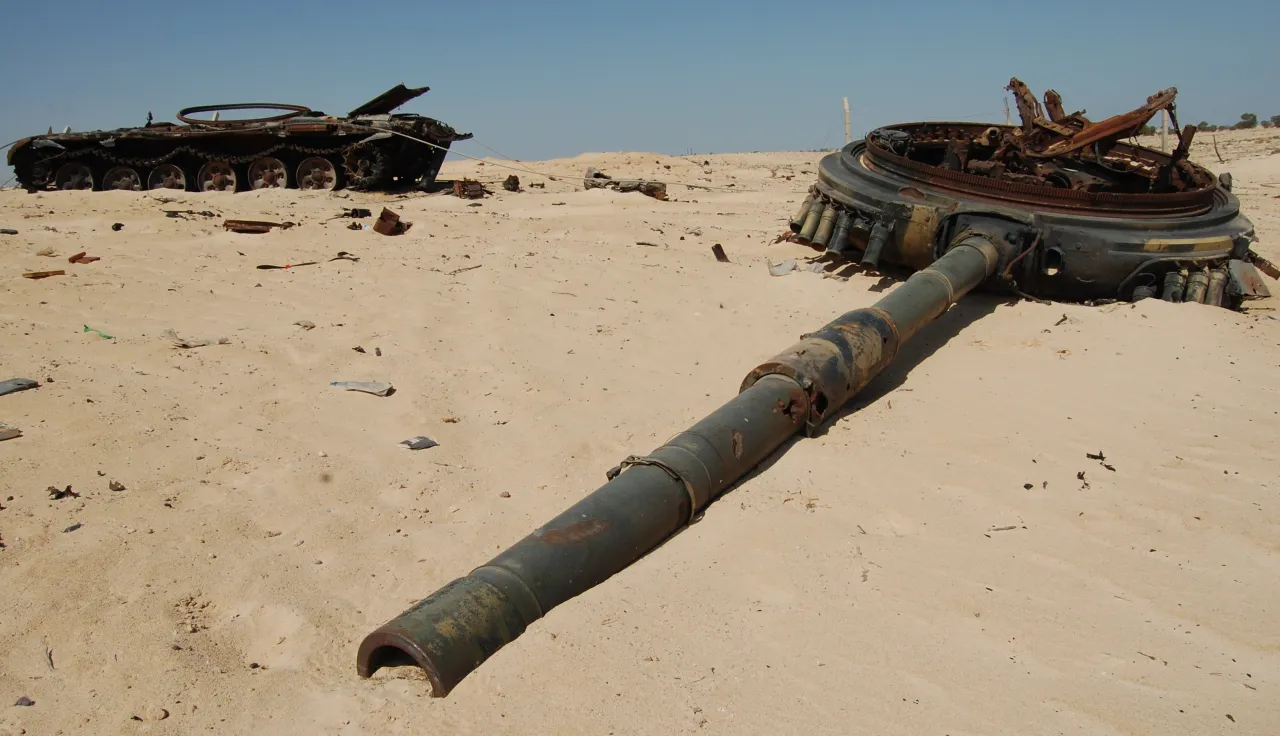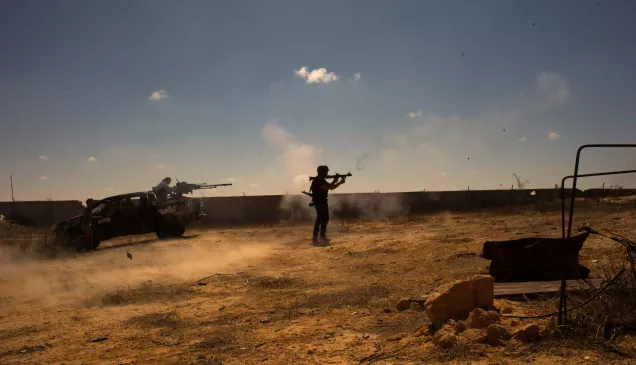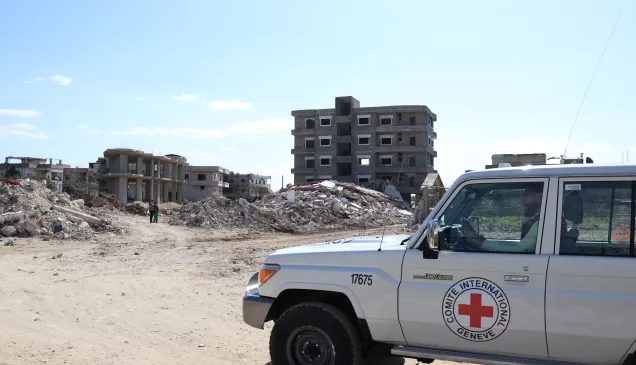The weapons issue: ICRC statement to the United Nations, 1996

A great deal has occurred this year in relation to the regulation of both conventional weapons and weapons of mass destruction. Actually, there is no such dual categorization of arms in international humanitarian law, which regulates all weapons in accordance with certain generally applicable rules in order to prevent excessive suffering and destruction. All of the work and comments of the International Committee of the Red Cross with regard to weapons, whatever their nature from a strategic standpoint, are aimed at assuring the faithful and impartial application of these rules of international humanitarian law.
Landmines
On 3 May of this year, the Review Conference of the 1980 UN Convention on Certain Conventional Weapons amended Protocol II (CCW) , which regulates the use of landmines. The ICRC has had the privilege, in keeping with its statutory mandate, to participate actively in this process.
The ICRC warmly welcomes a number of improvements in the landmines Protocol, in particular its extension to apply in both international and non-international armed conflicts, clear assignment of responsibility for mine clearance, requirements that the location of all mines be recorded, new protection for ICRC and other humanitarian workers, annual meetings of States Parties and a requirement that States punish serious violations of its provisions.
Unfortunately, the new limitations on the use of anti-personnel mines are both weak and complex, and there is hence a danger that these provisions will not be implemented in the types of conflict in which most recent use has occurred. In particular, poorly trained or equipped forces may be unwilling or unable to abide by a complex set of rules or pay an increased price for self-destructing mines. Further, the implementation of new provisions on detectability and self-destruction can be delayed for up to nine years after entry into force of the revised Protocol, which means around 2007. By that time we expect that mines will have claimed well over 200,000 new victims — unless States do far more than is required by the Protocol.
The ICRC will promote adherence to the amended Protocol II of the CCW. This Protocol is intended to restrict the use of mines, but it is not meant to encourage States to use mines or to invest in new types of mines. We urge States to go far beyond the provisions of the Protocol and to renounce the production, transfer and use of anti-personnel mines.
In March of this year, the ICRC published a study commissioned by it on the use and effectiveness of anti-personnel landmines in past conflicts [1]. This study was undertaken by high-level military officers and its conclusions are now endorsed by 52 senior commanders from 19 countries. The study found that the use of anti-personnel mines in accordance with law and doctrine is difficult, if not impossible, even for modern professional armies. This shows that the indiscriminate effects of landmines cannot be contained in most cases. Further it was found that the military utility of such mines is most often negligible or even counter-productive for the layer. The study theref ore concludes that the limited military value of anti-personnel mines is far outweighed by their human, economic and social costs.
Many States have already demonstrated that the end of the landmines crisis need not await a globally negotiated consensus. The "Agenda for Action" prepared by the Ottawa Conference in early October 1996 demonstrates how much can be done towards ending the landmines crisis through moral and political leadership [2] . We welcome the establishment of the "Ottawa Group", made up of some 50 States which committed themselves, in their final declaration, to promoting, and implementing initially on the national and regional levels, the global prohibition and elimination of anti-personnel mines. In this spirit, 25 States have already renounced or suspended the use of these weapons by their own armed forces and 11 are destroying their stockpiles. The Ottawa Group's dynamic agenda for the coming year stresses the urgency of both regional and global efforts, while highlighting the need to combine moves to achieve a ban with increased assistance for mine clearance and the care and rehabilitation of victims.
The ICRC strongly supports Canada's initiative in inviting Foreign Ministers to Ottawa in December 1997 to sign a new treaty totally prohibiting anti-personnel mines. We consider this step to be a major breakthrough and encourage States to respond favourably to the Canadian invitation. This initiative properly places the Ottawa Agenda for Action and other international initiatives in the context of urgent efforts to achieve a treaty banning these pernicious weapons. Even if such a treaty does not at first attract universal adherence, as has been the case with most new instruments, it will help create an important new norm.
Recent regional initiatives reflect the growing momentum towards a ban. A resolution of the Organization of American States , adopted last June, calls for the establishment of an "Anti-personnel Mine Free Zone" in the Americas. States of Central America, implementing an initiative by the Central American Parliament , have gone even further in pledging to prohibit the production, use and transfer of these arms. If such efforts are combined with generous assistance from the international community, Central America could become the first mine-infested region to free itself from this scourge. In February 1996 the Council of Ministers of the Organization of African Unity called on sub-regional organizations on the continent to move to prohibit anti-personnel mines, in keeping with the OAU's previous commitment to a total ban. In December 1995, Ministers of the Organization of the Islamic Conference also called for the "complete elimination" of this weapon.
In the context of this General Assembly the ICRC would advocate the adoption of the strongest possible resolutions, which:
- unequivocally support a global ban on, and the elimination of, anti-personnel mines;
- call on States to end the production, use and transfer of such arms by a certain date in the very near future;
- encourage the establishment of regional zones free of these weapons, pending the adoption of a global ban; and
- call for a significant increase in assistance for mine clearance and the care and rehabilitation of victims.
Arms transfers
The ICRC would again like to express its concern about the virtually unrestrained transfer of weapons and, in particular, small arms. Our experience in conflicts around the world is that enormous quantities of light weapons are available to virtually any individual or group which seeks them and that they are all too often used in flagrant violation of the norms of humanitarian law. Implementation of this law is made more difficult by the day as deadly weapons fall into more and more hands. In the coming year the ICRC will undertake a study, requested by the 26th International Conference of the Red Cross and Red Crescent, on the relationship between arms availability and humanitarian law violations. We will also be increasingly involved in dialogue on this issue within the International Red Cross and Red Crescent Movement.
Blinding laser weapons
The ICRC considers the adoption of Protocol IV prohibiting the use of blinding laser weapons to be a landmark achievement of the recent review process of the CCW [3]. Not only does this prohibit an abhorrent new means of warfare, but it also means that, for only the second time in history, the international community has been able to proscribe an inhumane weapon before having to witness its effects on the battlefield.
The ICRC encourages States to adhere to this new Protocol at the earliest opportunity and, when they do so, to make a formal declaration of their "understanding that the provisions of Protocol IV shall apply in all circumstances". Such a declaration would reflect the understanding reached when the Protocol was adopted at the first session of the CCW Review Conference in Vienna, and reaffirmed by 135 States at the 26th Int ernational Conference of the Red Cross and Red Crescent, that the Protocol "should apply not only to international armed conflicts". The Review Conference agreed, in its final declaration, on the need for achieving the "total prohibition of blinding laser weapons, the use and transfer of which are prohibited in Protocol IV". To this end we urge States, pending entry into force of the Protocol, to carefully monitor the relevant technologies and to ensure that such weapons are neither produced nor transferred.
Future weapons
The rapid advances in the technology required to produce portable blinding laser weapons highlight the need for States to meticulously review the development of new weapons, in keeping with their obligation to determine whether their employment would be prohibited by the rules of international humanitarian law. The ICRC, as the guardian of this body of law, will continue to follow such developments. The coming decades will undoubtedly see the emergence of new capabilities for the deployment of arms the nature of which would undermine this law and whose use humanity would come to regret. Protocol IV demonstrates that the international community can act to prevent such developments.
Chemical and biological weapons
The ICRC welcomes the imminent entry into force of the 1993 Chemical Weapons Convention and urges all States which have not yet done so to become parties to it. This Convention, by prohibiting the production and stockpiling of chemical weapons, is an important reinforcement of the proscription of the use of poison, which has roots in very long-standing customary law and has been codified in several treaties.
Likewise, we encourage States to adhere to the Biological Weapons Convention, which, like the Chemical Weapons Convention, strengthens the Geneva Protocol of 1925 which banned the use of chemical and biological weapons. We urge States Parties to equip the Biological Weapons Convention, at the upcoming Review Conference, with the most effective possible mechanisms for transparency, monitoring and verification.
Advisory Opinion of the International Court of Justice on the Legality of the Threat or Use of Nuclear Weapons
Finally, the ICRC would like to comment briefly on the Advisory Opinion of the International Court of Justice on the Legality of the Threat or Use of Nuclear Weapons [4].
This was the first time that the International Court of Justice analysed at some length international humanitarian law governing the use of weapons. We were pleased to see the reaffirmation of certain rules which the Court defined as "intransgressible", in particular the absolute prohibition of the use of weapons that are by their nature indiscriminate as well as the prohibition of the use of weapons that cause unnecessary suffering. We also welcome the Court's emphasis that humanitarian law applies to all weapons without exception, including new ones. In this context we would like to underline that there is no exception to the application of these rules, whatever the circumstances. International humanitarian law is itself the last barrier against the kind of barbarity and horror that can all too easily occur in wartime, and it applies equally and at all times to all parties to a conflict.
Turning now to the nature of nuclear weapons, we note that, on the basis of the scientific evidence submitted, the Court found that " ...The destructive power of nuclear weapons cannot be contained in either space or time ... the radiation released by a nuclear explosion would affect health, agriculture, natural resources and demography over a very wide area. Further, the use of nuclear weapons would be a serious danger to future generations... "In the light of this the ICRC finds it difficult to envisage how a use of nuclear weapons could be compatible with the rules of international humanitarian law.
The ICRC is convinced that because of their devastating effects no one ever wants to see these weapons used. It is our earnest hope that the opinion of the Court will give fresh impetus to the international community's efforts to rid humanity of this terrible threat.
International Committee of the Red Cross
Notes
1. Editor's note: Anti-personnel landmines — friend or foe? A study of the military use and effectiveness of anti-personnel landmines, ICRC, Geneva, 1996.
2. Editor's note: Towards a global ban on anti-personnel landmines , Declaration of the International Strategy Conference, Ottawa, 3-5 October 1996, see below, p. 647.
3. Editor's note: Louise Doswald-Beck, "New Protocol on blinding laser weapons", IRRC, No. 312, May-June 1996, pp. 272-299.
4. Editor's note: International Court of Justice, Legality of the threat or use of nuclear weapons, Advisory opinion of 8 July 1996.



